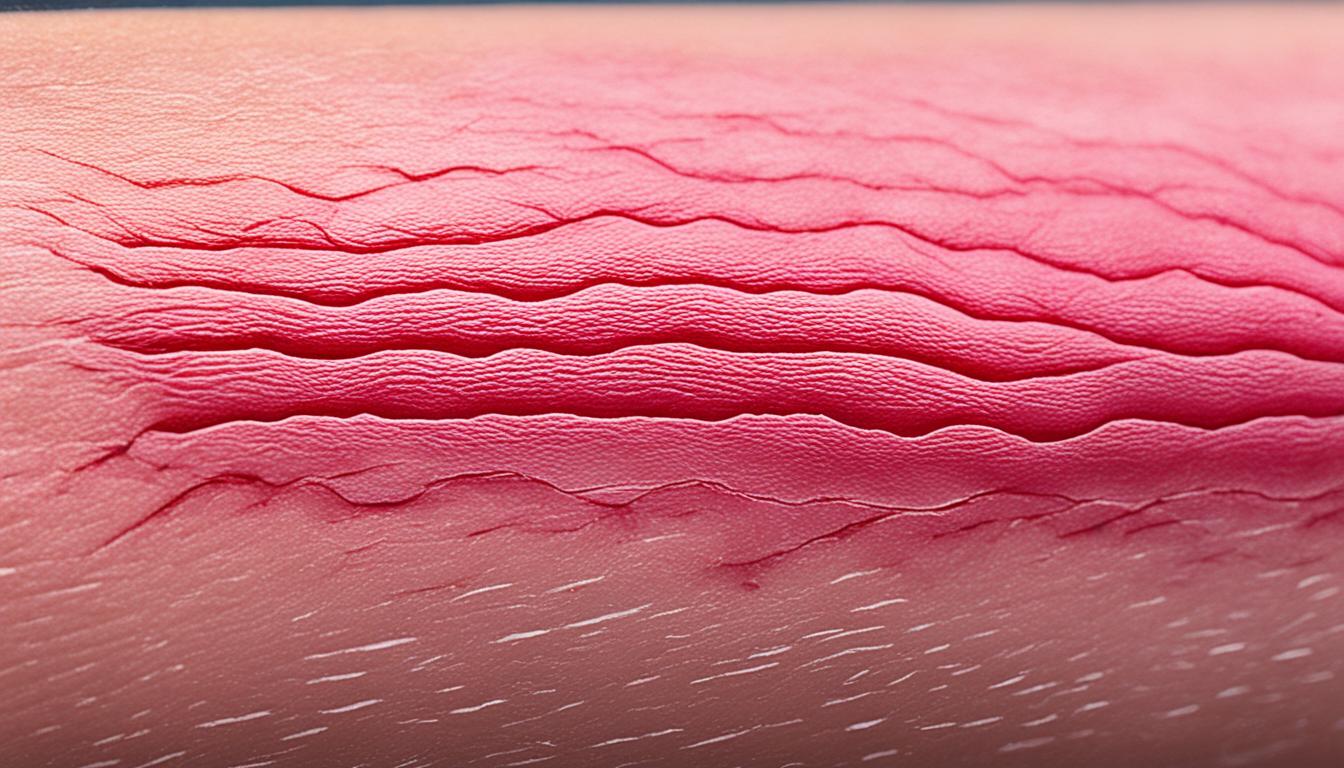Dermatographism is a skin condition where the skin gets red and swollen when it’s touched. This happens quickly, usually in just a few minutes. It can start at any age, but it’s most common in people in their younger years.
The exact cause of dermatographism is not clear. But, when your skin is damaged, it might release something that causes an allergic reaction. This reaction leads to the symptoms we see: redness, swelling, itching, and a rash.
This skin issue can really affect how someone lives, especially because it can make sleeping difficult and cause tiredness.
Key Takeaways:
- Dermatographism is characterized by an exaggerated weal and flare response.
- It can appear at any age, but it is most common in young adults.
- Skin trauma may release an antigen that triggers the release of histamine and other inflammatory mediators.
- Dermatographism can cause redness, swelling, itching, and rash.
- It can have a significant impact on quality of life, leading to sleep disturbance and fatigue.
Who gets Dermatographism and What Causes It?
Dermatographism is a skin issue that can show up in anyone, especially young adults. It doesn’t favor any race or gender. This means it can happen to anyone.
While most patients are healthy, dermatographism can sometimes be related to scabies. Scabies is a skin problem caused by mites. It might make dermatographism symptoms worse.
Some drugs can make people have symptoms like dermatographism. However, not all drugs do this. The effect can differ from person to person.
It’s not clear if there is a strong link between dermatographism and being prone to allergies. Some studies say yes, but many more are needed to know for sure.
Summary:
- Dermatographism can affect individuals of all ages, but it is most commonly seen in young adults.
- There is no racial predilection or differences between the sexes regarding dermatographism.
- It can be associated with scabies and certain medications.
- The relationship between dermatographism and atopy is still debated.
Comparison of Dermatographism Associations
| Association | Presence |
|---|---|
| Scabies | Can trigger or worsen dermatographism symptoms |
| Medications | Some medications may induce dermatographism-like symptoms |
| Atopy | Debated association; more research required |
Clinical Features and Diagnosis of Dermatographism
Dermatographism shows up as red lines or welts on the skin after being touched. These lines fade away within an hour. Sometimes, these welts might show up in places like the mouth and private areas.
Doctors say there are two types of this condition: one that’s simple and one that comes with symptoms. The simple kind doesn’t itch or cause much trouble. The symptomatic kind makes you itch, especially at night, and appears when the skin is lightly touched.
To check for dermatographism, doctors will lightly scratch or rub your skin. They look for the welts and red marks that show up. Sometimes, a special device called a dermographometer is used to do this.
If you take antihistamines before the test, it might not show up. That’s because antihistamines stop histamines, which are part of what causes dermatographism. So, the test might not work right if you’ve taken antihistamines.
| Features | Diagnosis |
|---|---|
| Appearance | Linear weals and red flare |
| Classification | – Simple dermatographism: Asymptomatic and common – Symptomatic dermatographism: Associated with itching, worsens in the evening or at night, and follows gentle stroking or light pressure |
| Affected Areas | Can affect mucous membranes such as the oral mucosa/lips and vulva |
| Diagnosis Method | Clinical examination by eliciting a response from the skin through firm stroking or scratching Use of a dermographometer for uniform pressure and recording skin responses |
| Antihistamines | May lead to a false negative result if taken prior to the test |
Stem Cell Therapy and Outlook for Dermatographism
The strategy to fight dermatographism mixes general steps with specific treatment options. General steps include wearing loose clothes to prevent skin irritation. It’s best to avoid triggers such as hot water or strong towel rubbing. Take care of any underlying issues, like treating scabies if needed.
If dermatographism heavily affects your life, therapy can be beneficial. Medications like anti-anxiety drugs or antidepressants help too. These methods aim to boost your well-being and lessen the emotional impact of dermatographism.
Doctors may prescribe strong, second-generation antihistamines for dermatographism. These include cetirizine or loratadine. Sometimes, treatments like phototherapy may be needed. Treatment plans depend on how well you respond to different approaches.
Results for dermatographism are not the same for everyone. Some people deal with it for months or longer. This is true especially for those with no known cause. But, if a clear cause is found, it might go away quicker. Always staying in touch with your doctor and updating your treatment plan is crucial. This helps to control the condition and improves your life quality.

